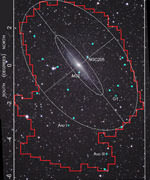
Image credit: RAS
An international team of astronomers has used the UK’s 2.5-m Isaac Newton Telescope on La Palma in the Canary Islands to map the Andromeda Galaxy (otherwise known as M31) and a large area of sky all around it. Their work over the last few years has created the most detailed image of a large spiral galaxy that currently exists. Dr Mike Irwin of the University of Cambridge, one of the team leaders, reports on some of the latest findings on Wednesday 31 March, when he will tell the RAS National Astronomy Meeting at the Open University about the first clear evidence that M31 is pulling one of its bright satellite galaxies apart, and the discovery of 14 previously unknown globular clusters orbiting far from the centre of M31 which could have been left behind when Andromeda devoured their parent galaxies.
Located around 2.5 million light years away, the Andromeda Galaxy is the most distant object visible to the naked eye, and is considered to be the sister galaxy of our own Milky Way. By studying this galactic neighbour, astronomers hope to understand more about the formation and evolution of many of the billions of spiral galaxies in the universe, including the Milky Way.
For their survey, the team have taken 150 individual images with a sensitive electronic CCD camera, which reveal millions of individual stars. It extends over an area 100 times greater than all earlier studies combined. The reason for scanning such a large area is that. around bright galaxies. there is a tenuous “halo” of stars which are leftovers from the formation of the galaxy billions of years ago. Studying this “fossil” information reveals evidence for how the halo, and hence the rest of the galaxy, has built up over cosmic history.
Traditionally, galaxy halos were thought to be relatively smooth and devoid of substructure. In fact the new survey shows that Andromeda’s halo is the exact opposite: it has a wealth of structure, indicating that it has ripped apart smaller galaxies that came too close and that the halo is built up from their remains. “Given that the disk of Andromeda appears so pristine, we were shocked to discover that its halo shows so much evidence for a history of interactions with other galaxies,” says Mike Irwin.
At this year’s National Astronomy Meeting, the Andromeda team report the discovery of a large stream of stars which appears to have been pulled out of one of Andromeda’s well-known satellite galaxies, NGC205. The visible part of the apparent stream extends nearly 50,000 light years from the main body of this small elliptical galaxy and was previously unknown despite the fact that NGC 205 has been well-studied.
“This is the first clear indication that one of Andromeda’s companion galaxies is being ripped apart as we watch,” commented team member Alan McConnachie, a doctoral student at Cambridge.
The 14 globular clusters the team has found orbiting far out from M31 may be evidence of Andromeda’s past cannibalism. Globular clusters are ancient systems of hundreds of thousands of stars, which are seen around many galaxies, and provide many clues to their evolutionary history. “Since the most distant of these globular clusters is some 250,000 light years from the centre of M31, our work shows that M31’s halo extends far beyond the edge of the bright part of the galaxy disk,” said Avon Huxor of the University of Hertfordshire.
“Both these discoveries will greatly aid in understanding the evolution of these nearby galaxies and should shed light on how our own Galaxy became what it is today,” commented Nial Tanvir, another team member from the University of Hertfordshire.
Original Source: RAS News Release
